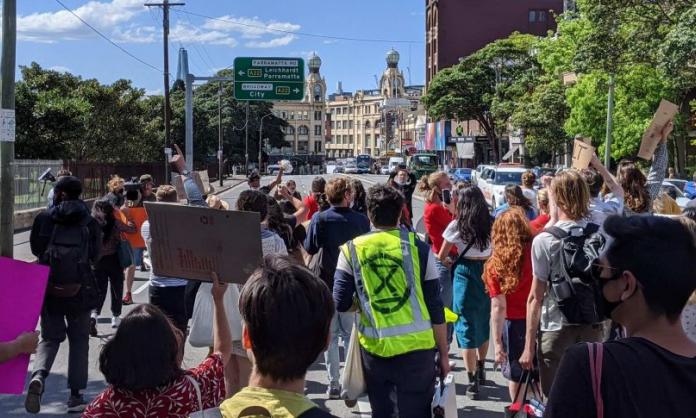While there is broad consensus on the left that we need to defend the right to protest, there are debates about how to respond to police repression.
One tactic being put forward is to stick with trying to organise decentralised protests, where groups of fewer than twenty assemble in separate locations, sometimes within eyeshot of each other, but hundreds of metres apart. The idea is that this gets around the ban by complying with the health orders while still allowing some kind of dissent to be expressed.
There are many problems with this approach.
The first is that it has failed to prevent repression. The police have simply declared that the separate groups, even though they may be hundreds of metres apart, are still gathered for the “common purpose” of protest. At Sydney University, this tactic was tried on 16 September, with protesters even going to the length of slightly varying the issue that each group was protesting about, to try to demonstrate that they weren’t really there for a “common purpose”. Nevertheless, the protest was broken up by police, and ten protesters were arrested and/or fined.
This raises the question: if they are going to arrest and fine us for protesting in tiny groups anyway, then why not ditch the decentralisation charade and instead protest in the most powerful way possible? This means all together, with the biggest numbers we can, which can inspire those involved and all those looking on, outrage all those who witness the police trying to bust up a popular mass movement and perhaps even give us a chance to resist the police repression at some point.
This is precisely what happened at a Sydney Uni protest on 23 September, when hundreds of students gathered and defied the police, taking to the streets, getting more support and media coverage than all previous protests combined and inspiring all those who took part, and many others who witnessed it, to escalate the fight. Far from the centralised action alienating people, as some argued it would, it has had the opposite effect. This should hardly be a surprise: mass protests are empowering in a way that twenty-person gatherings simply are not.
Second, the decentralisation approach does not challenge the anti-democratic ban on protests. It just accommodates it. School Strike for Climate called no protests in NSW for the Global Climate Strike on 25 September, only tiny photo ops, despite Morrison’s planet-destroying policies. There is a danger that some on the left will lower their horizon so much that they now try only to “win” the “right” to protest in tiny groups of fewer than twenty. Increasingly elaborate, cunning schemes and legal challenges are being put forward to “win” this rather pitiful “right”.
The Sydney Uni protest has now given the campaign for the right to protest serious momentum. The Democracy is Essential campaign had 100 people attend an organising meeting in late September, and awareness and anger over the protest ban are starting to build in wider layers of people. If people were now to frame their protest plans politically and legally around just being able to gather in groups of twenty—even if such an approach succeeded in court—it would be a step backward and allow the government and the police to maintain the lie that protest is not banned in NSW.
Some argue that “decentralisation” is not so much about finding clever ways around the law, but clever ways around the police. Small groups of scattered protesters, the argument goes, makes it harder, or at least slower, for the cops to stop us assembling, round us all up and shut down our protests. The tactics of this are dubious. Multiple semi-secret locations for rallies are an extra barrier to getting people involved who are not already part of the left. The danger is that we bamboozle ourselves more than we do the cops.
Furthermore, for some, this is just a fudged, more radical-sounding version of the previous argument for capitulation to the undemocratic ban on protests. Of course, no-one should argue for “centralisation” or “decentralisation” on principle when it comes to protests; these are tactical questions.
This leads to the third key problem with “decentralisation”: tiny protests are ineffective. Don’t get me wrong: I’ve both organised and attended hundreds of tiny protests in my time. Sometimes they’re all we can do, and they’re usually better than nothing. They can help cohere small groups of activists, or kick off a campaign, or perhaps get a bit of media attention if you’re lucky. But let’s not kid ourselves—protests of fewer than twenty, even several of them at the same time, never changed the world. They won’t stop the attacks on our university staff; they won’t challenge structural racism or threaten the Morrison government.
Josh Lees is part of the Democracy is Essential—Restore the Right to Protest in NSW campaign, and was arrested and fined for a protest at Sydney University on 31 July.








